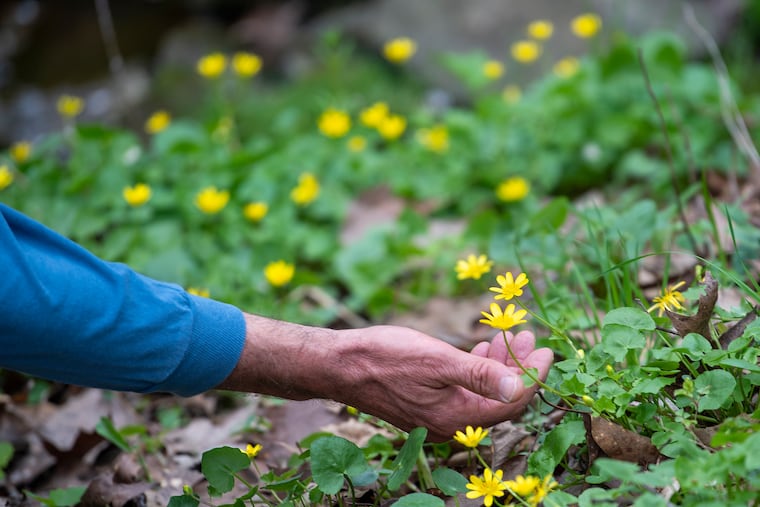The tyranny of the buttercups: Lovely, and taking over the Philly region with a big assist from the weather
The lack of extreme cold and heat and prolonged snow cover have been perfect for the spring blooms and blossoms, and for a dangerous invader.

In a splendidly colorful and vibrant spring orchestrated by a fortuitous alignment of weather circumstances, the innocuously named “fig buttercup” is having the time of its life, decorating stream banks, hillsides, and yards with flowers “bright as the sun, himself,” in the words of William Wordsworth.
A 19th-century poet’s endorsement notwithstanding, Mark Gormel, horticultural coordinator at the Brandywine Conservancy, and other plant specialists around the country wouldn’t mind if this particular buttercup, known more properly as the lesser celandine, disappeared — like yesterday.
“Pretty is, as pretty does,” he said this week. “It’s not exactly pretty.”
It’s a dangerous import, a master conqueror, rapidly spreading and effectively smothering competitors, garden experts warn. Conservancy founder George Weymouth famously painted the bluebells on his property; the buttercups are blamed for suffocating them.
They are notorious for imposing a vegetative “monoculture” upon a given area, gentle plant-speak for monopoly. “It’s a very invasive weed,” said Roger Davis, outdoor landscape manager at Longwood Gardens, in Kennett Square, adding that a creek bank he passes on his way home from work has turned “solid yellow.”
They do prosper near stream beds, and they proliferate through an unlikely and unwitting assortment of four-legged and two-legged Johnny Appleseeds. They sprout and open before other plants, wildflowers, and blooms, and then outlast them.
» READ MORE: Happy Equinox Day, Philly. Spring has a way of energizing humans and the atmosphere.
While the daffodils and magnolia and cherry-blossom petals are bowing out after their triumphal tours, the fig buttercups continue basking in the sun — not that they particularly care about the sun now: They do just as well in the shade and even better in the rain.
They will seem to disappear in June. You might think you got rid of them. They will find that humorous.
What are these things?
They are native to parts of Asia, Africa, and Europe, where they enchanted Wordsworth, who probably is more celebrated for his rhapsody on daffodils and romantic poetry than weed-pulling. The fig comes from the shape of its underground tubers.
They evidently were imported as ornamentals and have pursued a career parallel to that of the starling, the bird brought to Central Park in New York for a Shakespeare Festival in the late 19th century and went on to take over the continent.
» READ MORE: Credit (or blame) the Bard for the much-admired, much despised starling
It is unclear when these buttercups first were introduced to North America, but it is known that they were present in Philadelphia by 1867, and that by 2009 they had found their way to Texas. They now inhabit just about every state east of the Mississippi, and the Pacific Northwest.
Shoots typically appear in late winter, and the flowers open in March and April, mining sunlight beaming through the leafless trees. Wet grounds along streams are their favored environments, but they get around, their tiny, aboveground bulbils commuting on the hoofs of deer, paws of other animals, and human shoes.
Mike Van Clef, program director of the New Jersey Invasive Species Strike Team, said he has seen lesser celandine on a bone-dry rock outcropping. Said Van Clef, who also is the stewardship director for the Friends of Hopewell Valley Open Space, in Mercer County: “The stewards probably tracked it up there.”
Van Clef said the lesser celandine has taken over the Garden State and it has happened in a hurry. “Thirty years ago, it wasn’t a thing. It’s blown up in the last two decades.”
And if you’re seeing more of them than ever this spring, that might have a lot to do with the weather.
Buttercup weather
“I’d say it’s been a very pretty spring,” said Carol Long, garden curator at Winterthur, in northern Delaware. “Things did come on quickly. I was surprised how quickly.”
Said Jeff Lynch, grounds manager at Chanticleer Gardens, in Wayne: “It definitely has been an incredible bloom year. I’ve never seen the cherries as beautiful as they were this year.”
For the region’s plant life, garden experts said, the winter was the perfect non-storm. It wasn’t terribly cold. In fact, only once did the temperature get below 20 officially in Philadelphia, which is highly unusual, so when the generous snows came, the ground wasn’t deeply frozen.
» READ MORE: Philly weather went from snow and ice to 56 degrees in just two days. It’s that time of year.
Some parts of the region ended up with as much as 4 feet of plant-insulating snow through February that gently melted and kept the soils moist during a March dry spell. After the blooms opened, the region largely avoided killing freezes and wilting warmth.
But along with the likes of daffodils and magnolia blossoms, the winter also was generous to the lesser celandine.
Fighting back
You can yank them, but proceed with caution, says Chanticleer’s Lynch: You have to excise all the bulbils and tubers that are the celandine propagators. The other option, of course, is chemical.
The Brandywine group recommends a 1%-2% glyphosate solution that can be applied when temperatures are over 40, but be careful not to kill the innocent. “You have to be selective,” said Brandywine’s Gormel.
The lesser celandine is almost a dead ringer for the puffier, less-aggressive marsh marigold. That can fool even an experienced gardener, said Lynch: “I had a professional person tell me a lesser celandine was a marsh marigold.”
The fig buttercups should be gone in June — on the surface. The underground tubers live on, and the plant’s efficient reproduction system virtually guarantees a reappearance next spring, and by then it might well have annexed new territory.
Said Gormel: “It’s a real difficult situation.”